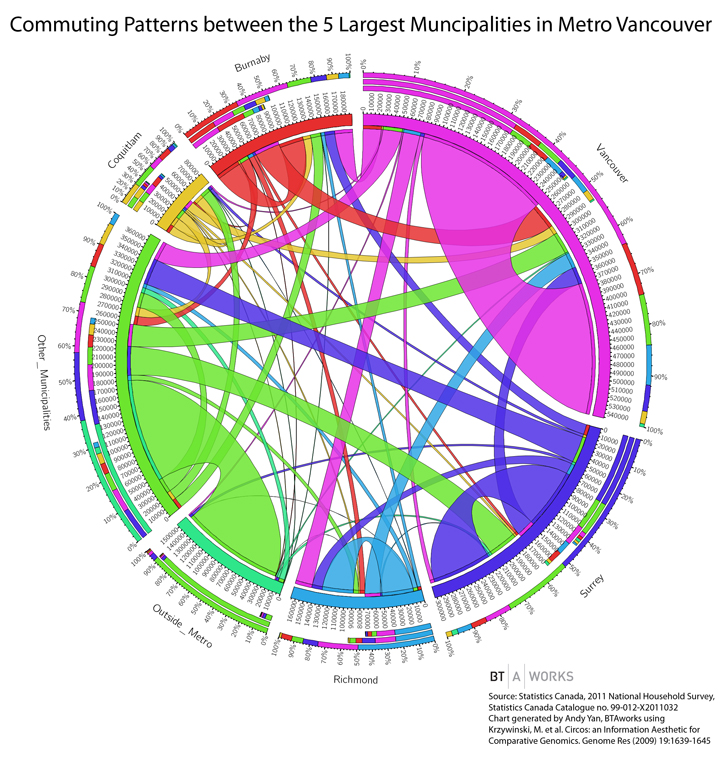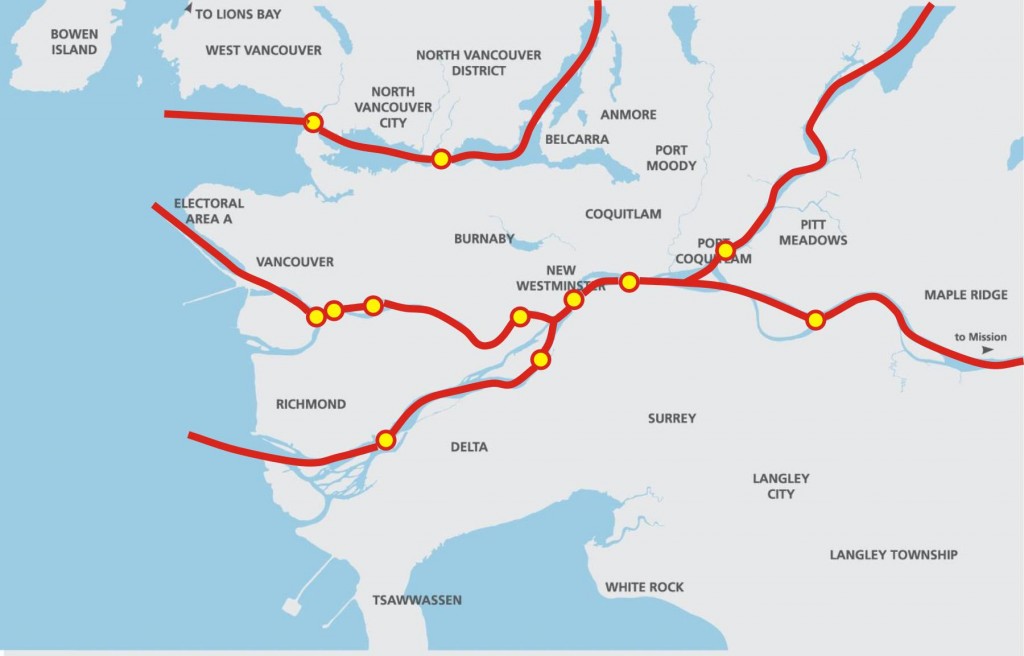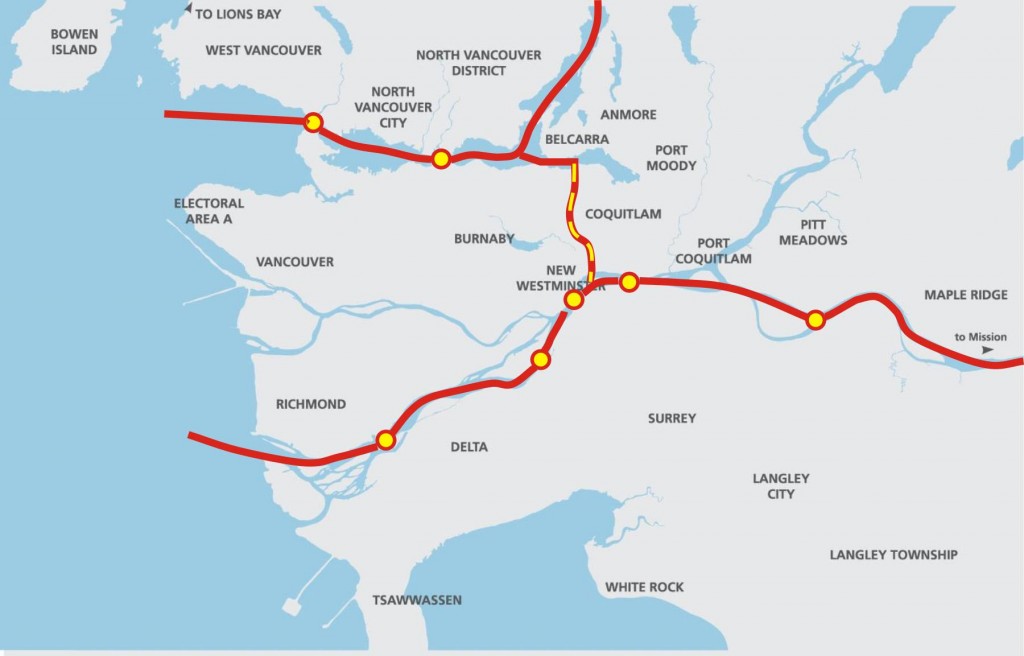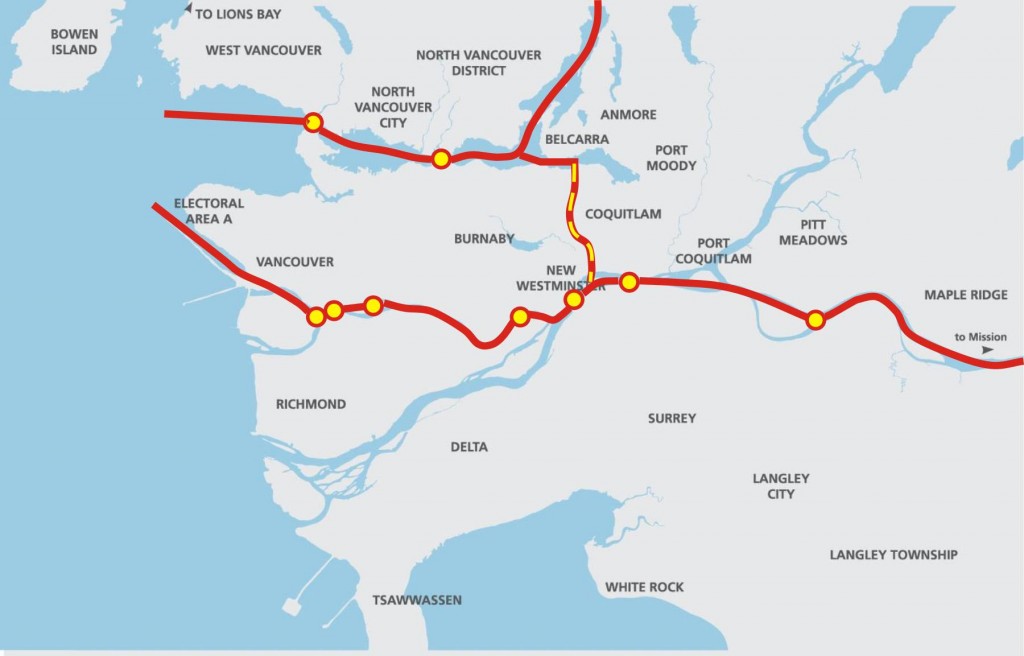I received this comment to my previous post about $1 tolls:
Another big problem, amongst others in this plan, is that it does not fairly distribute the burden on all Lower Mainland residents. I notice that nobody seems to think that the Burrard, Granville, Cambie, No. 2 Road, Dinsmore or either of the Moray Channel Bridges should be tolled. Therefore, if your objective is downtown Vancouver, all residents of Vancouver, Burnaby, Port Moody, New Westminster and Coquitlam are exempt from tolls. Ditto for any Richmond resident working at YVR. And yet, their cars place as much stress on the infrastructure and contribute to congestion/GHG emissions as a car coming from across the Fraser or Burrard Inlet.
There is a lot packed inside this succinct comment, and it deserves a fuller response that I can fit in a comment. If we decide to toll all/most bridges, which bridges do we toll?
The Mayor of Delta provided an analysis of tolling all crossings of the Fraser River and Burrard Inlet within the general TransLink area. I pointed out a problem with including the Laing bridge, as it is Federal, and YVR isn’t going to want someone else collecting tolls on their infrastructure that they built for their customers to use.
There are also (as noted in the comment) three more crossings of the middle arm of the Fraser (the No 2 Road, Dinsmore and Moray bridges) that all belong to the City of Richmond. There are also three bridges crossing False Creek (the Burrard, Granville and Cambie) that belong to the City of Vancouver. Should we expect those two cities to turn the infrastructure that they paid to build and still pay to maintain, over to regional tolling?
Should we expect their respective Mayors to take any different an opinion about this than the Mayors of the North Shore do when it is suggested their residents and businesses start paying tolls without a concomitant return in infrastructure investment for their residents and businesses?
Perhaps we are asking this question the wrong way. Instead of asking where we can toll, we should be asking what we want to achieve with a regional tolling strategy.
Although many appeal to “fairness”, that discussion usually devolves to getting someone else to pay more and the commenter to pay less. There is little fair in transportation funding. Pedestrians and cyclists subsidize drivers, transit users pay to cross rivers, drivers don’t. We all pay for TransLink whether we use buses ourselves or not. People in Vancouver are paying to build transit infrastructure in Prince George, but Prince George residents are not expected to pay for TransLink infrastructure, BC Ferries that run on tidewater are expensive, those that run on fresh water are free. It isn’t fair. Let’s put fair aside.
One thing we may try to do is manage the infrastructure we have more efficiently. The toll on the Port Mann has caused a decline in the use of that brand new and woefully underutilized crossing, and an offsetting increase in use of the aged, decrepit and congested Pattullo. When (if?) the Massey and the Pattullo are replaced with tolled crossings, the Alex Fraser is going to be a gong show. The idea of balancing tolls across the region is one way to address this issue.
Of course, flat tolls on all bridges is a pretty inelegant and inefficient way to do this. Dynamic tolling where off-peak crossing costs are lower than peak times, and even (gasp!) temporary reductions on some alternates when an incident or construction is causing one crossing to be jammed, are possibilities that could make our existing infrastructure carry loads better, and make road use more predictable. Of course, this is effectively the same thing as increasing capacity, and induced demand will result in the same net congestion within a few years anyway. Which brings us to the third (and best) reason to toll crossings.
Transportation Demand Management (TDM) is the only thing (emphasis needed here: *The. Only.Thing.*) that has ever been effective at reducing traffic congestion in urban areas. When we talk of “road pricing” or “congestion pricing”, we really mean using the forces of the market to adjust traveller’s behaviour. Airlines do it (it costs more to fly on Friday and at Christmas), Ski Hills do it (it costs more to take a lift on a Saturday in December than a Tuesday in March), Ships, Trains, Busses, Car Rental companies, hotels – they all do it. Charge more at peak times and less in slow times to encourage some percentage of riders to take the off-peak trip and save your need to build more capacity.
Except when we talk about an integrated regional transportation system, we can also incentivise different uses altogether. And herein lies some of the answer of which bridges we should toll.
“If your objective is downtown” is a compelling part of the comment. Translink constantly reminds us, the living in the burbs – working downtown model does not apply to Greater Vancouver (reason #437 why the PMH! Project was a silly approach). Look at this compelling diagram from BTAworks that shows where commuters travel. Most people from Surrey don’t commute to Vancouver, nor do most people in most communities.

However, there is no doubt the region has “zones” for the most part defined by water bodies, and just like we use those zones to determine transit use, we can use them to determine tolling policy.
The model suggested by the Mayor of Delta would divide the lower mainland into the following zones: the Mainland, South of the Fraser, Lulu Island, the North Shore and the North Valley.

Although I admire the simplicity, this does seem to create significant inconsistencies, and as the commentor noted, if I want to drive the 45km from Anmore to UBC, I pay no toll, while I would pay two tolls to go the 12km from New West to my favourite Indian Restaurant in North Delta (and this is, like most things, all about me).
This also creates as bit of a strange zone-in-the-middle out of Lulu island, which I suspect would be of concern to the City of Richmond. Or not. Their residents may hate the idea that every time they wish to go somewhere more than 3m above sea level (and bring their car along) they need to pay a toll. Alternately, they may like the idea that toll-in and toll-out will reduce through traffic and make their City streets work better for the residents that live there. I frankly don’t understand the politics of Richmond enough to predict where that discussion would go, but I would wager less tolls would be favoured.
A perhaps more logical model I once saw suggested was to consider the Burrard Peninsula as the “central zone”, and create three other zones: South of the Fraser, the Northeast, and the North Shore:
This creates the slightly complicated (but not insurmountable) challenge of tolling crossings of North Road (or some imaginary line that runs roughly parallel to it). This arguably distributes the burden better. The problem is what to do with Lulu Island. Does it belong North or South of the Fraser?
The answer in that probably lies in one of the fundamental assumptions of using road pricing as a TDM measure: You need to provide alternatives. Simply tolling a crossing where people have no choice but to drive will do little to disincentivize people from adding to the traffic, but will do much to anger people who used to get a crossing for “free”. Looking at Lulu Island, the transit options to the south through the tunnel and Alex Fraser are not great. However, the Knight, Oak, and Laird currently parallel one of the nicest, shiniest, newest transit lines to ever grace the Lower Mainland. The pedestrian and bike alternatives are also there. So from a TDM perspective, it makes sense to toll the four north arm crossings, not the two main arm crossings.
I agree, true distance-based road pricing is a better solution, but we are a decade or more from that being implemented, and we need to deal with a funding situation that is killing the regional transportation vision right now. Meanwhile we are bringing a bunch of new asphalt infrastructure into the equation within the next decade. I see a more regional tolling introduction as a good stop-gap measure, and we can no longer allow the perfect to be the enemy of the good. We need to get moving.
And yeah, $1 still isn’t enough.

1 Whatever we do to adjust tolling policy needs to address the need for accessibility first. When London introduced the congestion charge to reduce the number of cars entering the Central Area, they first greatly increased the number of buses and the lanes dedicated to bus use. This meant people who needed to be in the Central Area for whatever reason and did not want to pay the charge had a reasonable option. At the same time facilities for cycling were also increased.
2 Tolling based simply on bridge crossings, as your analysis shows, is inadequate at best simply because of the number of trips that do not cross a bridge. You show one option that uses North Road – but in reality what would probably be needed to affect behaviour (given more transit capacity) is a series of cordons.
3 There is an option that is now technically feasible – and has been used elsewhere. That is to change the way ICBC charges for car insurance to a per kilometre premium. However that does not address the peak issue at all. And ICBC refuses to consider it.
4 Which leads us back to dynamic real time Road Pricing – which has long been what we see for the future, just Not Now. And will I think be ever thus.
And as long as any new tax means a referendum – and the Mayors oppose (existing) property tax – then any progress is unlikely
I think TDM is also a way to impact mode-split, as well as temporal issues. Single-occupancy vehicles (SOVs) travelling at the peak of rush hour are the reason why we have congestion. Fewer cars, which would result from even a slight increase in the average # of occupants/vehicle, coupled with a “flattening of the peak”, would save billions in misguided road/bridge infrastructure investments. So how do we get there?
A good way to affect behaviour is to tax it.
While I continue to advocate for a full mobility pricing system, vs. a bridge-by-bridge toll, a key element of either plan must be a “carrots and sticks” approach to TDM. Reward good behaviour (tolling exemptions for HOVs or electric vehicles, reduced tolls for shoulder periods), and penalize behaviour which we want to change (full tolls for peak hour travelling, toll premiums for SOVs).
This could be implemented on a full region mobility approach, by substituting the word “rate” for “toll”. HOV lanes would still be in place at all bridges, which provides a non-rate incentive (although, time IS money) to supplement the per-KM rate.
You could even implement a similar approach on transit. Flatten the peaks by creating another rate tier at the peak of rush hour. With the Compass system, I would guess that it would be relatively easy to choose a time band where anyone who taps in during that period pays a premium?
Anyways, it’s a great discussion to have, and an important one for the future of the region.
Thanks Stephen and Stevenson. Excellent points all around. I wonder if this is the type of discussion Ministers Fassbender and Stone are having?